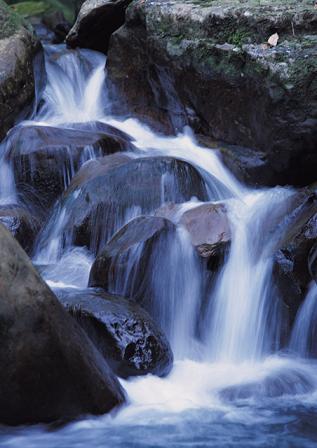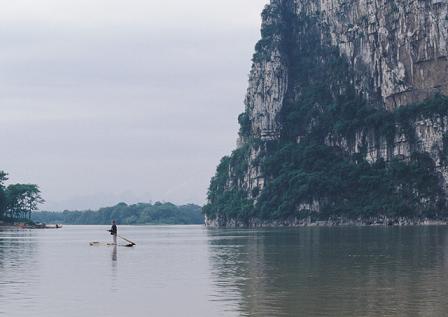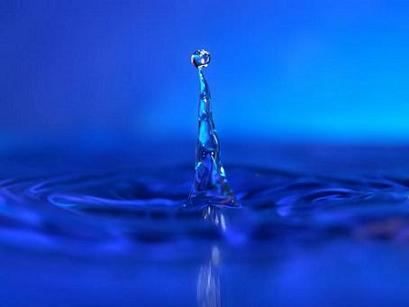NATURE'S
WATER CYCLE
| The waters of Earth move continuously from the oceans, to the air, to the land, and back to the oceans again. The sun's heat evaporates water from the oceans. The water rises as invisible vapor, and falls back to Earth as rain, snow, or some other form of moisture. This moisture is called precipitation. Most precipitation drops back directly into the oceans. The remainder falls on the rest of Earth. In time, this water also returns to the sea, and the cycle starts again. This unending circulation of the Earth's waters is called the water cycle or hydrologic cycle.
Because of nature's water cycle, there is as much water on Earth today as there ever was-or ever will be. Water changes only from one form to another, and moves from one place to another. The water you bathed in last night might have flowed in Russia's Volga River last year. Or perhaps Alexander the Great drank it more than 2,000 years ago. |

|
The waters of Earth.
Earth has a tremendous amount of water, but almost all of it is in the oceans. The oceans cover about 70 percent of Earth's surface. They contain about 97 percent of all the water on Earth, and are the source of most precipitation that falls to Earth. Ocean water is too salty to be used for drinking, agriculture, or industry. But the salt is left behind during evaporation, and the precipitation that falls to Earth is fresh water.
Only about 3 percent of the water on Earth is fresh water-and most of it is not easily available to people. It includes water locked in icecaps and other glaciers, more than 2 percent of Earth's water. About half of 1 percent of Earth's water is beneath Earth's surface. Rivers and lakes contain only about one-fiftieth of 1 percent of Earth's water.

Water in the air.
At one time or another, all the water on Earth enters the air, or atmosphere, as water vapor. This vapor becomes the life-giving rain that falls to Earth. Yet, the atmosphere contains only one-thousandth of 1 percent of Earth's water.
Moisture in the air comes mostly from evaporation. The sun's heat evaporates water from land, lakes, rivers, and, especially, the oceans. About 85 percent of the vapor in the air comes from the oceans. Plants also add moisture. After plants have drawn water from the ground through their roots, they pass it out through their leaves as vapor in a process called transpiration. For example, a birch tree gives off about 70 gallons (260 liters) of water a day. Corn gives off about 4,000 gallons per acre (37,000 liters per hectare) daily.
Precipitation.
Vapor is carried by the air moving over Earth. The moisture-filled air cools wherever it is forced up by colder air or by mountains or hills. As the air cools, the vapor condenses into droplets of liquid water, forming clouds. The droplets fall to Earth as rain. If the vapor is chilled enough, it condenses into ice crystals, and falls as snow.
About 75 percent of the precipitation falls back directly on the oceans. Some of the rest evaporates immediately-from the surface of the ground, from rooftops, from puddles in the streets. Some of it runs off the land to rivers. From the rivers, it flows back to the sea. The rest of the precipitation soaks into Earth and becomes part of the ground water supply. Ground water moves slowly through the ground to the rivers and returns to the sea. This movement of ground water to rivers keeps the rivers flowing during periods without rain.
How water shapes Earth.
Water changes the face of Earth as it moves through the great water cycle. Water wears down mountains, carves valleys, and cuts deep canyons. It also builds deltas and straightens coastlines.
During precipitation, some water falls on highlands and mountains. The force of gravity pulls the water downhill. As the water flows to lower levels, it erodes (wears away) the soil and rocks. In this way, after many thousands of years, mountains are worn down. The water that runs off the land during precipitation cuts small channels. The small channels drain into larger channels. The larger channels drain into still larger ones, until finally the water empties into the main stream that runs to the sea. The water then flows to the sea carrying the materials it has eroded from the land.
Some of the precipitation that falls is captured in mountain glaciers. As the glaciers slide down mountainsides, they cut the mountains into sharp and jagged peaks.
The ocean also changes the face of the land. As waves pound against the shore, they cut away land and leave steep cliffs. Much of the material the waves wear away from the land is carried far out to sea. Some piles up near shore in sand bars. For more information on how water shapes Earth.

How water began.
The question of how water began on Earth is part of the question of how Earth itself began. Many scientists believe Earth was formed from materials that came from the hot sun. These materials included the elements that make up water.
|
|
As Earth cooled and grew solid, water was trapped in rocks in Earth's crust. The water was gradually released, and the ocean basins filled with water. Other scientists have other ideas about how Earth and water began.
Next >>>
Contributor: Thomas M. Keinath, Ph.D., Dean, College of Engineering, Clemson University.
... |
|



